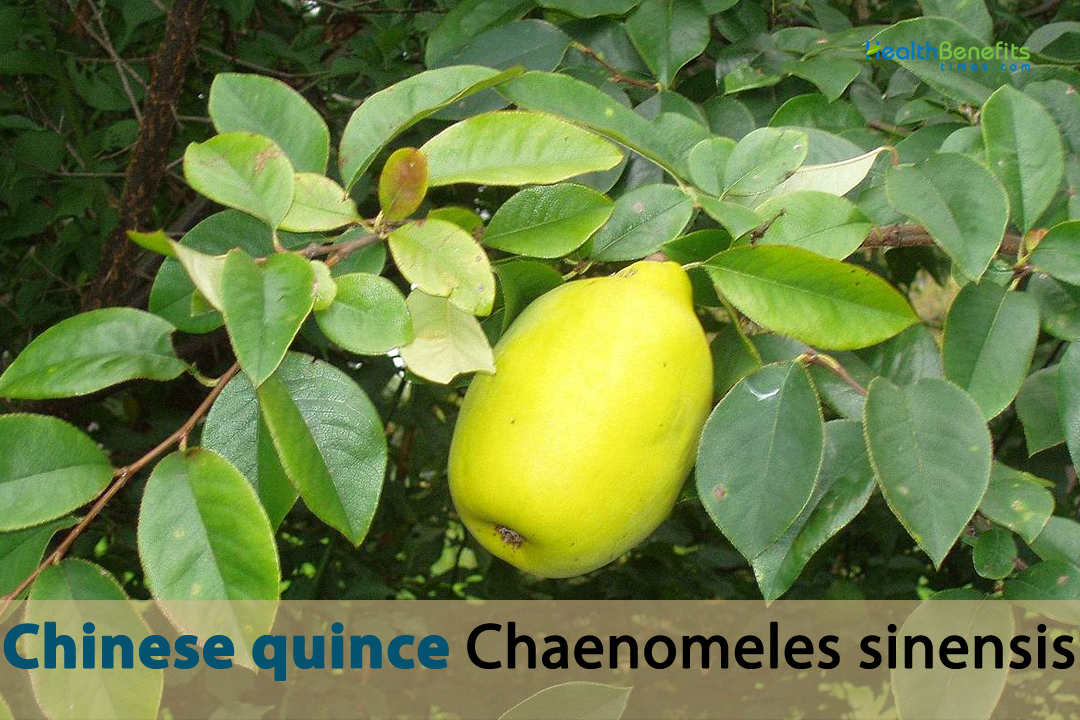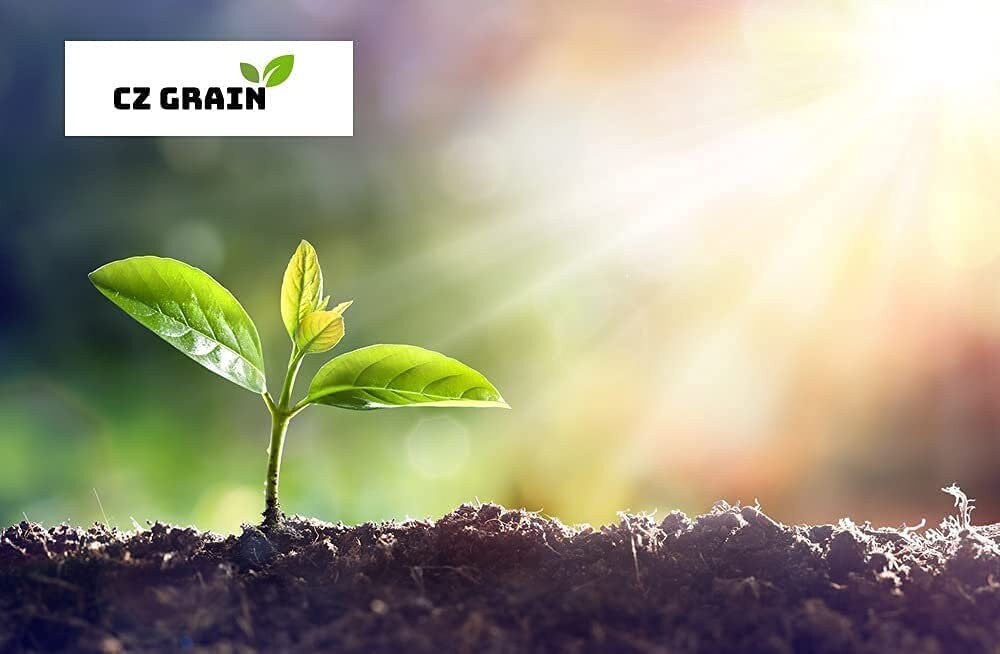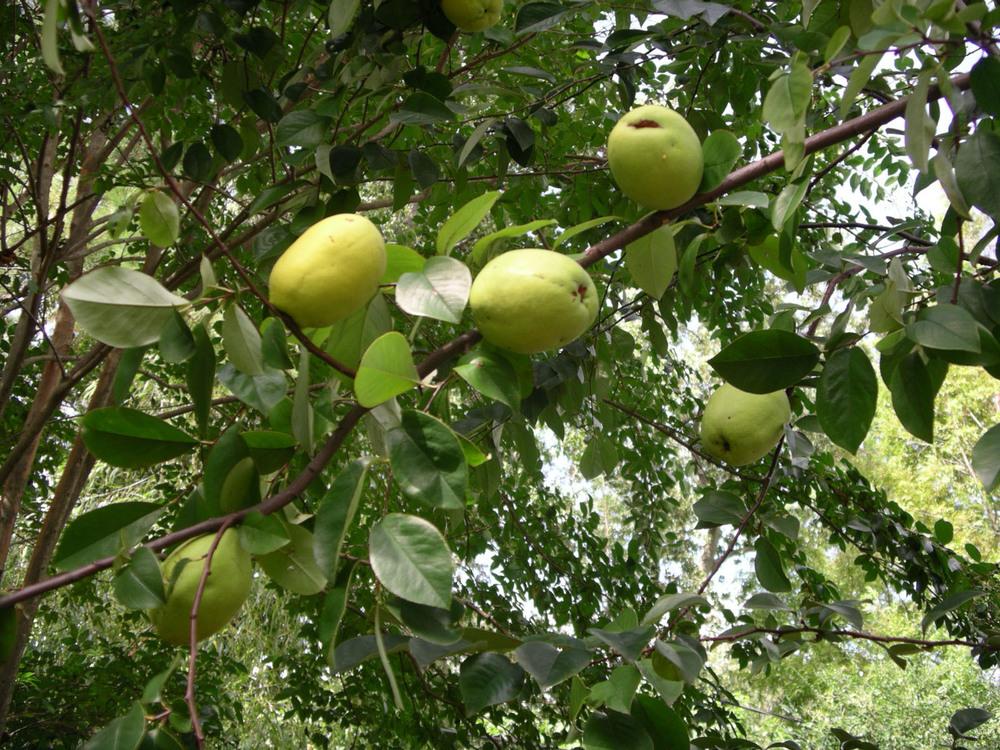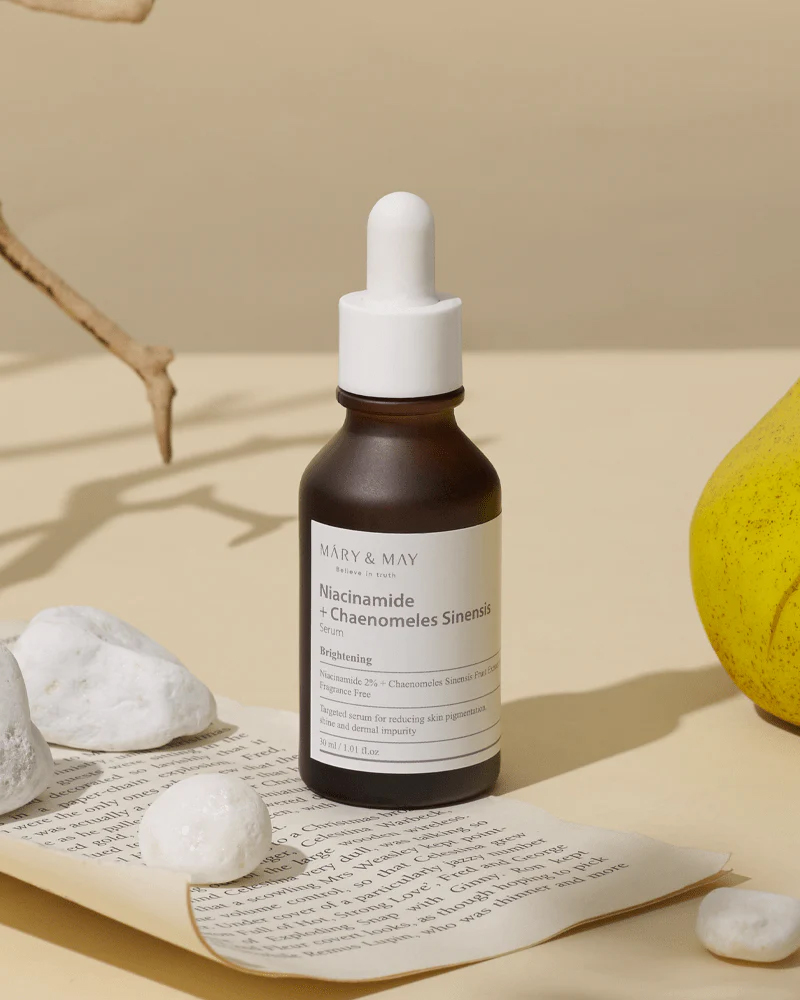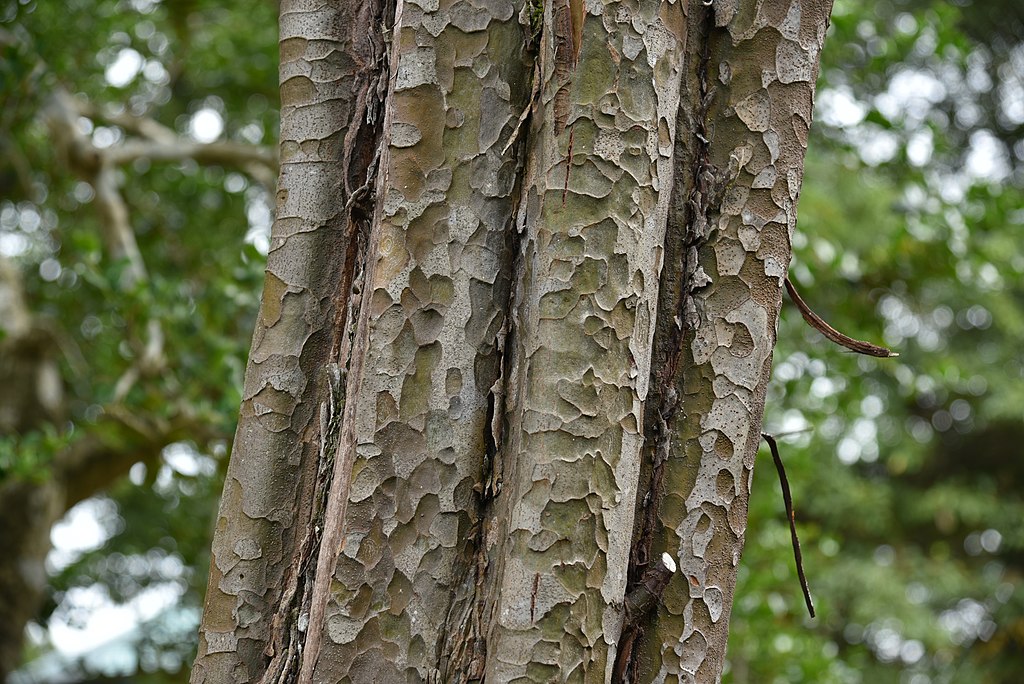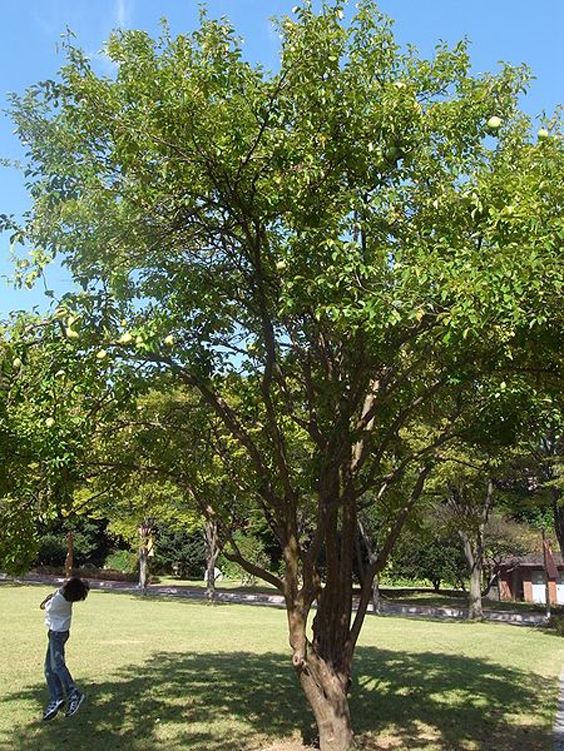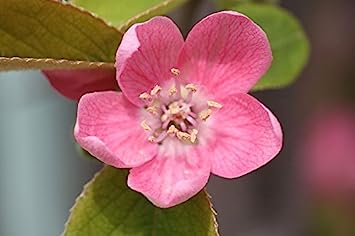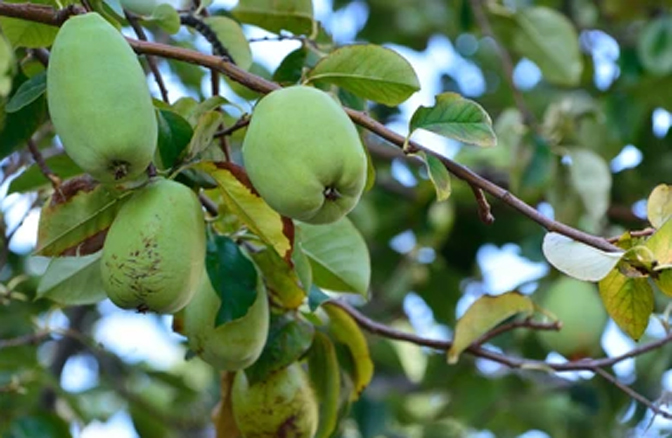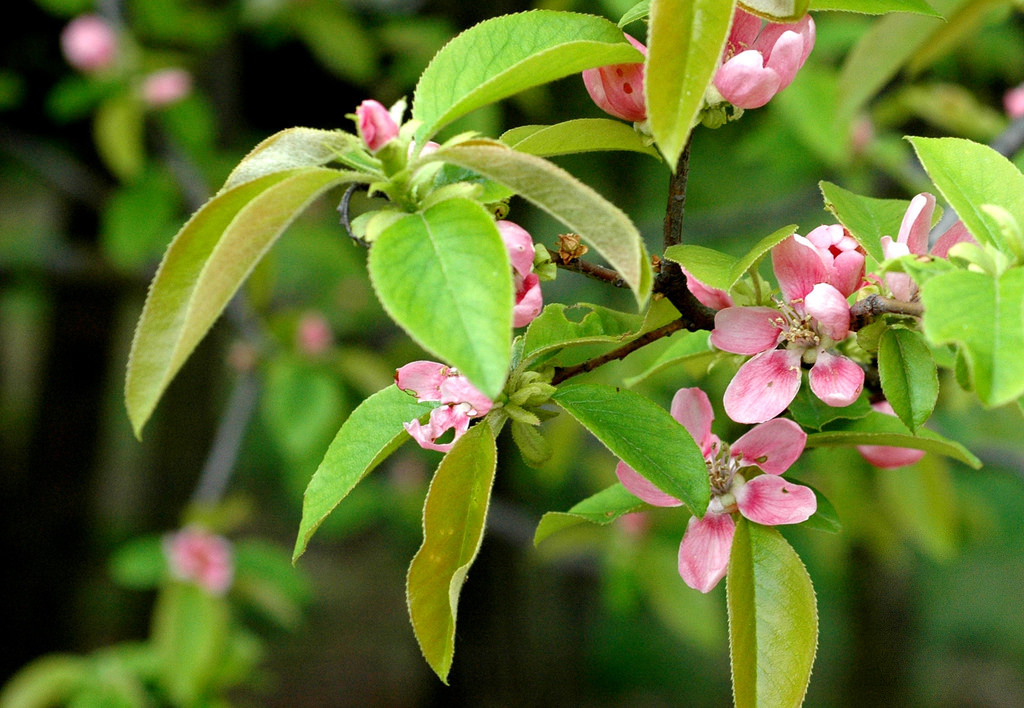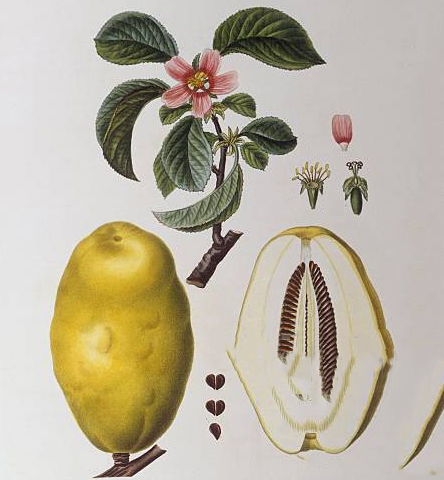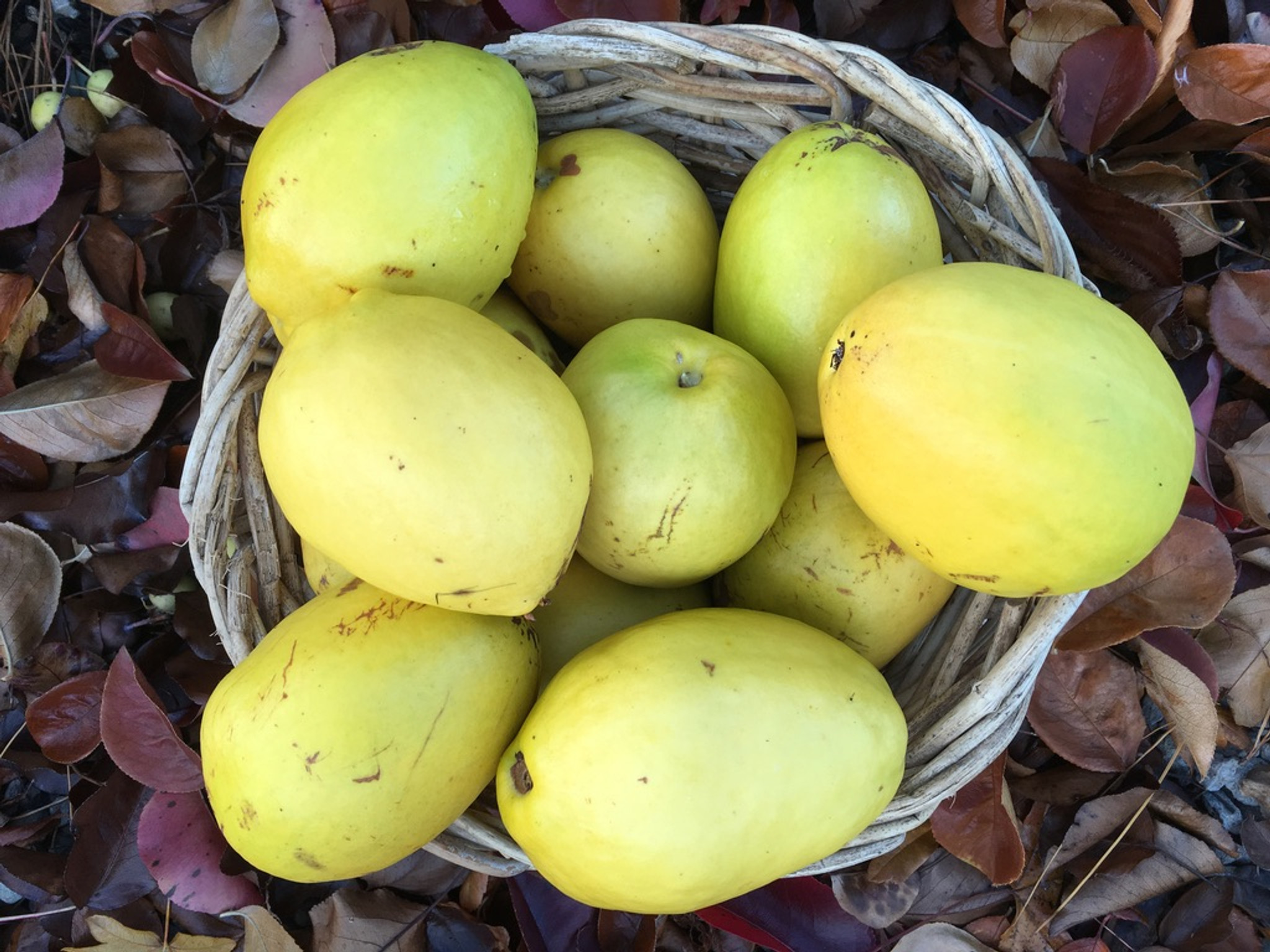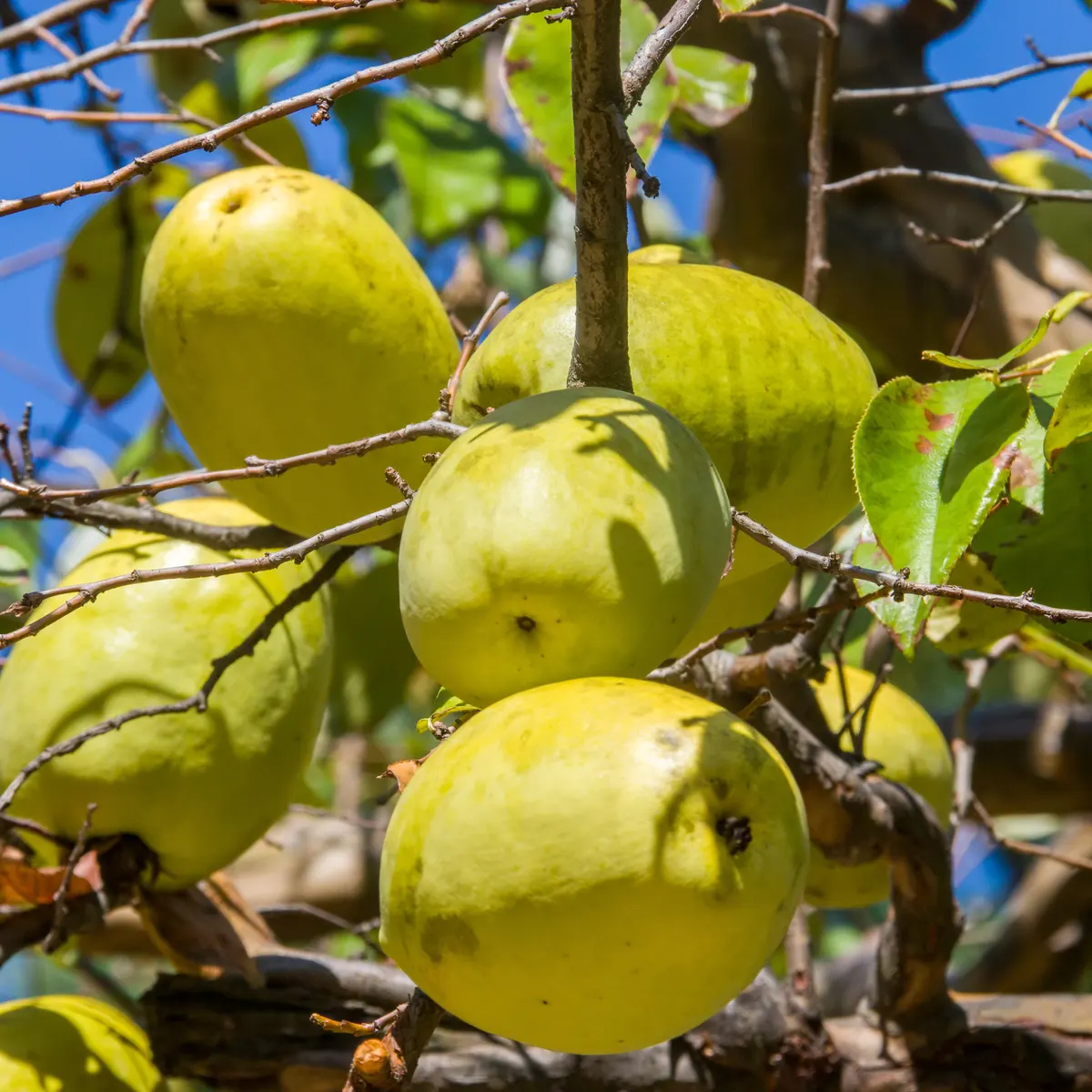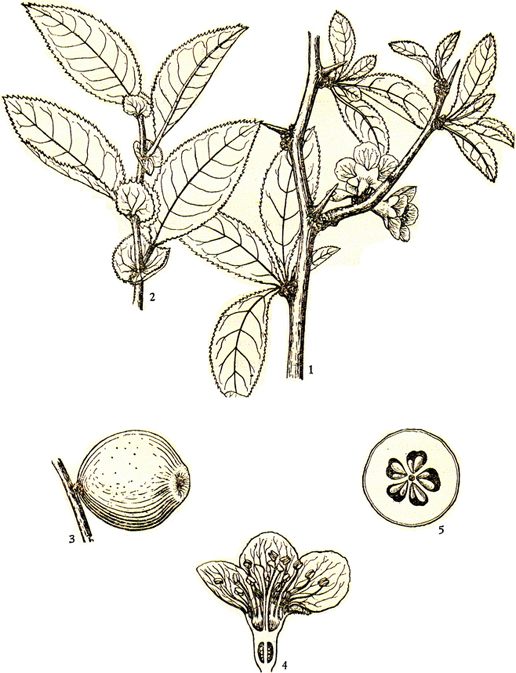| Chinese quince Quick Facts | |
|---|---|
| Name: | Chinese quince |
| Scientific Name: | Chaenomeles sinensis |
| Origin | Mountainous regions of central and eastern China |
| Colors | Initially green turning to yellowish-green color with a fuzzy texture as they mature |
| Shapes | Small to medium-sized, typically measuring about 2 to 3 inches (5 to 7.6 centimeters) in diameter |
| Taste | Delightful blend of tartness, sweetness, and astringency |
| Health benefits | Digestive disorders, coughs, skin conditions, common cold, sore throats, mastitis, diarrhea, inflammatory diseases, mastitis and tuberculosis. |
| Name | Chinese quince |
|---|---|
| Scientific Name | Chaenomeles sinensis |
| Native | Mountainous regions of central and eastern China |
| Common Names | Chinese quince, Flowering quince, Ornamental quince, Chinese flowering quince, Chinese flowering pear, Chinese golden apple, Chinese apple, Chinese pear, Chinese kumquat, Chinese bush cherry, Fire blight-resistant pear, Fire blight-resistant quince, Apple quince, Japanese quince, Maule’s quince, Chaenomeles, Oriental quince, Japanese apple, Rock quince, Hawfinch apple, Scarlet storm quince, Toyo-Nishiki quince, Japanese flowering quince, Kwanzan quince, Crimson and Gold quince, Salmon pink quince, Pink Lady quince, Double take series quince, Red star quince, Fruiting quince, Hardy quince, Winter quince, Rose quince |
| Name in Other Languages | Afrikaans: Chinese kweper Albanian: Spec i Kinezëve Amharic: Quince China Arabic: Al-safarjal alsini (السفرجل الصيني), Safarjal sini (سفرجل صيني) Armenian: Khenomeles ch’inakan (խենոմելես չինական) Assamese: China kuins (চীনা কুইন্স) Basque: Txinako lemoa Belarusian: Chienamielies kitajski (хенамелес кітайскі) Bengali: China koinz (চীনা কইন্স) Bosnian: Kineska dunja Breton: Krugenonez Bulgarian: Kitayska dyulya (Китайска дюля) Catalan: Codonyer xinès Chichewa: Quince ya China Chinese: Zhōnghuá mùguā (中華木瓜), Hai tang, Mu gua, Mu li, mù guā (木瓜), Míng zhā (榠樝), Mùguā hé (木瓜核), Mùguā pí (木瓜皮), Mùguā zhī (木瓜枝), Suān mùguā (酸木瓜), Mùguā gēn (木瓜根), Mùguā huā (木瓜花), Mùguā (mó zhā, zhā) (木瓜(模楂、楂)), Míng zhā (冥楂), Mùguā (木瓜), Hǎitáng (海棠) Corsican: Cotugnu chinu Croatian: Kineska dunja Czech: Křížal japonský, kdoulovec čínský Danish: Kinesisk kvæde Dutch: Chinese kweepeer, Chinese kweeappel English: Flowering quince, Chinese-quince Estonian: Hiina kibuvits Fijian: Dua ni quince e Saina Finnish: Kiinanruusunmarja French: Cognassier de Chine, Coing de Chine Galician: Marmeleiro chines German: Chinesische Quitte, Chinesischer Quittenbaum, chinesische Scheinquitte Greek: Kinezikí kydonía (Κινεζική κυδώνια), Kinézikο agkinári (Κινέζικο αγκινάρι), Kinézikο kissómilo (Κινέζικο κισσόμηλο) Gujarati: Chāinīj kwinzs (ચાઇનીઝ ક્વિન્સ) Hausa: Quince na Sin Hawaiian: Pūpūka hua Kina Hebrew: Havatzelat sinit (חבצלת סינית), Havatzelat sinitit (חבצלת סיניתית) Hindi: Cheenee kwinz (चीनी क्विंस), Chainīz qīns (चायनीज़ क़ीन्स) Hungarian: Kínai birs Icelandic: Kínversk þörungaplant Igbo: Nwanyị Chiina Indonesian: Buah kunci Tiongkok, Apel kuin Cina, Buah kuin Cina Irish: Coinínis tsean-Choire Italian: Mele cotogne cinese, Cotogno cinese Japanese: Niwanashi (ニワナシ), Karanashi (カラナシ), Karin (カリン), Kiboke (キボケ), karino (カリノ) Kashmiri: Cheeni quince (چینی کوئنس) Kinyarwanda: Quince ya China Konkani: Chini kwinz (चीनी क्विन्स) Korean: Hwanggeum bae (황금 배), Jungguk bae (중국 배), mo gwa na mu (모과나무) Lithuanian: Kininė kriaušė Latvian: Ķīnas ābols Macedonian: Kineska kvince (Кинеска квинце) Malagasy: Voanavony Sinoa Malay: Quince Cina, Kuin Cina, Pokok kuin Cina Maltese: Kwiċċin tal-Ċina Manipuri: China kuins (চীনা কুইন্স) Maori: Kapuhi Haina Marathi: Chīnī kwinz (चीनी क्विंस) Norwegian: Kinesisk kvede Oromo: Quince Tsainaa Polish: Pigwa chińska, Pigwowiec chiński Portuguese: Marmeleiro chines, Marmelo chines, Marmeleiro da China Punjabi: Cīnī kuvins (ਚੀਨੀ ਕੁਵਿਂਸ), Cīnī kuviṁsa (ਚੀਨੀ ਕੁਵਿੰਸ) Romanian: Gutuia chineză Russian: Kitayskaya aiva (Китайская айва), Ayva kitayskaya (Айва китайская) Samoan: Quince Saina Scottish Gaelic: Crann coingeis Shìona Serbian: Kineska kvinca (Кинеска квинца) Sesotho: Qoentshe ea China Setswana: Quince ya China Shona: Quince yaseChina Sindhi: Cheeni quince (چيني ڪوئنس) Slovak: Čínska kutina Slovenian: Kitajska kutina Somali: Uunsi Qunis Sotho: Qoentshe ea China Spanish: Membrillo chino, Membrillero chino Swahili: Quince ya Kichina Swazi: Iquince yaseChina Swedish: Kinesisk kvitten Tahitian: Kōnihi porokini Tamil: Cīṉa kiṉs (சீன கின்ஸ்), Cīṉa kuviṉs (சீன குவின்ஸ்) Telugu: Chainīs kwinzs (చైనీస్ క్విన్స్), Caina kvinzs (చైనా క్విన్స్) Thai: Lūksālī jīn (ลูกสาลี่จีน), Lūksǒmthai jīn (ลูกส้มไทยจีน) / Lūkmeuangthai jīn (ลูกเมืองไทยจีน) Tigrinya: Quince China Tongan: Siensi kuinsi Turkish: Çin ayvası, Çin elması Ukrainian: Kitayska aiva (Китайська айва), Ayva kytaysʹka (Айва китайська) Urdu: Cheeni quince (چینی کوئنس) Venda: Quince ya China Vietnamese: Cây mệ quất Trung Quốc, Mộc qua Trung Quốc, Mận Trung Quốc, Cóc Trung Quốc Welsh: Cywydd Tsieineaidd, Mwyar Tsieinaidd Xhosa: Iquince yaseChina Xitsonga: Quince ya China Yoruba: Apu Chaiina Zimbabwean Ndebele: Quince yaseChina Zulu: Iquince yaseChina |
| Plant Growth Habit | Unarmed, deciduous to semi-evergreen, medium-sized shrub or a small tree |
| Growing Climates | Thrives in full sun to partial shade. Select a location in your garden that receives at least six hours of sunlight daily. Ensure the soil is well-draining and fertile, as the plant prefers moderately moist conditions |
| Soil | Prefers well-draining soil that is fertile and moderately moist. It can tolerate various soil types but performs best in loamy or sandy soil |
| Plant Size | Grow between 1.5 to 3 meters (5 to 10 feet) in height and spread |
| Root | The main anchor of the plant is the taproot, which gives it structure and support. From the taproot, a lot of straight roots grow out. |
| Stem | Stem is made of wood and has a circular shape. It is made up of different layers and cells that work together to support the plant and move things that are important to it |
| Bark | Bark is usually rough and can have different patterns on it. As the plant grows, it may get furrows, ridges, or shallow lines |
| Leaf | Leaves are alternately arranged, simple, 6–12 cm long and 3–6 cm broad, and with serrated margin |
| Flowering season | From February to April |
| Flower | Flowers are 2.5–4 cm diameter, with five pale pink petals; flowering is in mid spring |
| Fruit Shape & Size | Small to medium-sized, typically measuring about 2 to 3 inches (5 to 7.6 centimeters) in diameter. |
| Fruit Color | Initially green turning to yellowish-green color with a fuzzy texture as they mature |
| Seed | Small and oval-shaped |
| Flavor/Aroma | Sweet, floral, and subtly fragrant |
| Taste | Delightful blend of tartness, sweetness, and astringency |
| Plant Parts Used | Fruit, seeds, bark, flower |
| Propagation | By seed, Stem cutting, layering, grafting and division |
| Lifespan | Can live for 20 to 30 years or more |
| Season | From August to October |
| Major Nutrition |
|
| Varieties | • Crimson and Gold • Nikko • Chojuraku • Cido • Jet Trail • Toyo-Nishiki • Cameo • Sargentii • Chojuho • Hollandia • Contorta • Crimson Storm • Sargentii Splendens • Moerloosei • Cameo Quince • Cido Oriental • Pink Lady • Scarlet Storm • Simone • Ruby |
| Health benefits |
|
Plant Description
Chinese quince is a medium-sized shrub or small tree that grows between 1.5 and 3 meters (5 to 10 feet) in height and width. It has no thorns and is either semi-evergreen or loses its leaves in the autumn. The tree’s top is full and round. Most of the time, the branches are long, arched, and full of thorns. Depending on the type of plant and how it is pruned or trained, the general shape can be different. The plant does best in either full sun or some shade. Choose a spot in your yard that gets sunlight for at least six hours a day. The plant does best in rich, fairly moist soil that drains well. It can grow in many kinds of soil, but it does best in sandy or loamy soil. Make sure the dirt drains well so it doesn’t get waterlogged. Too much water can cause root rot. Once it is established, the shrub is easy to take care of and only needs a modest amount of water.
Appropriate growing environment for Chinese quince
Chinese quince thrives in specific growing conditions. Here’s an overview of the appropriate growing environment for Chinese quince:
- Climate: The Chinese quince grows well in mild areas with clear seasons. It likes to live in places where winters are mild to average and summers are warm. During winter dormancy, it can live in temperatures as low as -15°C (5°F), but it may need to be protected from heavy frost.
- Sunlight: The best place for Chinese quince is in full sun to part shade. It needs at least 6 hours of direct sunshine a day to grow and make fruit as well as it can. Make sure the spot where you plant gets a lot of sunlight for good growth.
- Soil: Chinese quince grows best in dirt that drains well and is rich and loamy. It does best in soil that is slightly acidic to neutral, with a pH between 5.5 and 7.5. Root rot can happen in grounds that are too wet or have too much clay. Adding organic matter to the soil, like fertilizer, can help it drain better and have more nutrients.
- Watering: Once it’s established, Chinese quince can handle dryness pretty well, but it needs to be watered often when it’s dry, especially when it’s growing. Water deeply and let the soil dry out a bit between watering to keep it from getting too wet.
- Pollination: Chinese quince needs cross-pollination to produce fruit. Having other compatible pollinators close, such as other types of Chaenomeles or related species, can help the plant set more fruit. Pollination works best when bees and other insects are around.
- Pruning: Chinese quince grows well when it is trimmed and shaped. Regular pruning, ideally in late winter or early spring before new growth starts, keeps the size of the plant manageable, encourages airflow, and helps the plant make healthy fruit. Remove stems that are dead, broken, or sick, and thin out growth that is too close together.
- Pests and Diseases: Most pests and diseases don’t bother Chinese quince. In humid conditions, it could get aphids, scale insects, and fungus diseases like powdery mildew. Check on the plant often and use the right organic or chemical controls if you need to.
- Space and Support: Chinese quince can be grown as a free-standing shrub or taught to grow against a wall or trellis. Make sure there is enough space between plants, usually 1.5 to 2 meters (5 to 6.5 feet), so that air can flow and plants can grow.
Roots
Most Chinese quinces have a taproot system, which means they have one main root that goes straight down. The main anchor of the plant is the taproot, which gives it structure and support. From the taproot, a lot of straight roots grow out. These side roots grow in different ways, branching off and going deeper into the ground. They are very important because they help plants get water and nutrients from the dirt around them. Chinese quince also grows adventitious roots, which are roots that grow from parts of the plant that are not roots, like stems or twigs. Most of the time, these roots grow near the base of the plant and help it take in more nutrients and hold itself up.
There are many small root hairs on the roots. These root hairs make the roots much bigger, which makes it easier for the plant to take in water and nutrients. Most of the nutrients are taken in through the root hairs.
Stem
Most of the time, the stem is made of wood and has a circular shape. It is made up of different layers and cells that work together to support the plant and move things that are important to it. The bark, which is the top layer of the stem, acts as a protective layer. The bark can be rough and brownish-gray, but this is not always the case. Under the bark is a thin layer of cells called the epidermis, which covers the stem. The epidermis keeps the body from losing too much water and protects the organs underneath.
Under the skin is a part of the stem called the cortex, which is made up of parenchyma cells. The cortex gives the plant structure and is a place where nutrients are stored. Vascular bundles, which are made up of xylem and phloem tissues, are embedded in the brain. The xylem moves water and minerals from the roots to the rest of the plant, while the phloem moves sugars and other organic chemicals from the leaves to the rest of the plant. There are small, raised bumps called lenticels on the surface of the stem. Lenticels let gas move between the stem and the air around it, which helps the plant breathe. As the stem gets older, more and more xylem tissue builds up. This makes wood. The wood gives the stem strength and stiffness, which helps it hold up the weight of the leaves, flowers, and fruits.
Bark
Bark is usually rough and can have different patterns on it. As the plant grows, it may get furrows, ridges, or shallow lines. The bark can be any color between brown and greyish brown. Cork cells, which are dead cells with thick walls, make up the bark’s top layer. These cells offer extra protection by making a barrier that keeps water from escaping and keeps microorganisms out.
There are small, raised bumps called lenticels all over the surface of the bark. Lenticels make it possible for gases like oxygen and carbon dioxide to move between the inside of the stem and the air around it. They make it easier for the plant to breathe. The bark’s main job is to guard the stem’s inner tissues from damage, disease, and other stresses from the environment. It works as a barrier against things like bugs, diseases, and extreme temperatures that come from the outside.
Leaves
On the stems, the leaves are grouped in pairs. This means that each leaf is placed on its own and changes sides as you move up the stem. Most leaves are oval or ovate, which means they are narrow and long with points at the ends. Leaves can have smooth or slightly jagged edges. The leaves have a pinnate vein pattern, which is made up of a prominent midrib going down the middle of the leaf and smaller veins that branch off from it. The top side of the leaves is smooth and shiny, while the bottom side is generally rougher and less shiny. Depending on the type of Chinese quince, the taste may be a little different.
The leaves are usually a dark green color, which makes them look nice next to the flowers and fruits. Different types may be a little different shades of green. The size of the leaves can change based on how old the plant is and what kind it is. Most of the time, the leaves are between 3 and 7 cm long. Stipules are small, leaf-like parts that grow at the bottom of leaf stalks. They are often found with leaves. Stipules can be different sizes and shapes, and when the leaf bud is young, they protect it. The leaves are very important to the growth and life of the plant as a whole. They use sunshine to turn carbon dioxide and water into carbohydrates and oxygen through a process called photosynthesis. The leaves also help the process of transpiration, in which extra water vapor is released through small holes on the leaf surface called stomata. Also, the leaves help the plant breathe, which lets the plant and the air around it trade gases.
Flowers
The flowers of the Chinese quince grow from the leaf axils, which are the angles between the top of a leaf and the tree. They can be found alone or in small groups on the trees. Most Chinese quince flowers are single, which means they grow on their own instead of in groups or inflorescences. Each flower has several petals that are all lined up in the same way. The shape of the flower is like a bowl or cup, and it has five petals that are often round or oval. Depending on the cultivar, the petals can be different colors of red, pink, orange, or even white. Chinese quince flowers can be small or medium-sized, but they are usually small. The flowers range in size from about 2 to 5 centimeters across.
The flowers of the Chinese quince usually bloom in late winter or early spring, before the leaves are fully grown. The flowering time can change based on the type of plant and the weather. Some cultivars make flowers that smell good, which adds to their total beauty. But not all types have a smell that you can smell. Insects, like bees and butterflies, are drawn to the bright colors and nectar of Chinese quince flowers. The flowers have both male and female sexual parts, so they can pollinate themselves. Cross-pollination between different plants, on the other hand, can happen and lead to genetic variation. The flowers of the Chinese quince are very valuable as decorations. They are often grown because of how bright and beautiful they look, which makes them popular in parks, landscapes, and flower arrangements.
Fruits
The form and look of Chinese quince fruits are unique. Most of the time, they are round or slightly oblong, and their skin is rough. When the fruit is ready, the skin can be yellow, greenish yellow, or golden. Chinese quince fruits are usually small to medium in size, with a width of about 5 to 8 centimeters on average. But the size of the fruit can change based on the cultivar. The skin of Chinese quince fruits is generally rough and feels a little fuzzy or velvety to the touch. When it’s not ripe, the fruit’s flesh is hard and crisp, but as it ripens, it gets softer and juicier.
When eaten raw, the taste is sour and acidic. They have a unique flavor that tastes like apple and pear mixed together. Some kinds may taste a little sweeter than others. People often use Chinese quince fruits in cooking and other food preparations. You can use them to make jams, jellies, preserves, and sweets with fruit. They can also be used to add a tangy flavor to savory meals like stews or braised dishes.
Seeds
Most of the time, the seeds of a Chinese quince are small and oval-shaped. They have a hard shell around the seed that protects the baby inside. The seeds can be different colors, but most of the time they are dark brown or black. The seeds are in the middle or core of the fruit. The meat or pulp surrounds the seeds. When conditions are right, the seeds of a Chinese quince can sprout and grow into new plants. When the seed has enough water, air, and the right temperature, the process of germination begins.
History
Chinese quince comes from China and has been grown there for thousands of years. People think it came from the hilly areas of central and eastern China. In the 1800s, the Chinese quince was brought to Europe. European botanists and explorers saw how beautiful and useful it could be for gardening. This led to it being grown in gardens and farms all over the continent. As an ornamental plant, Chinese quince became famous in Europe and other parts of the world. Its colorful flowers, tasty fruits, and thorny branches made it a popular plant for parks and other outdoor spaces. Today, the Chinese quince is grown in many places with temperatures that are good for it, such as Europe, North America, and Asia. It is grown both as a decoration and for the fruit it makes.
Varieties of Chinese quince in detail
The Chinese quince is a species that encompasses several cultivated varieties, each with its own unique characteristics. Here are some notable varieties of Chinese quince in detail:
- Crimson and Gold: This type is known for its showy, dark red flowers and golden-yellow fruits. It is a popular decorative cultivar that is liked for the contrast of its bright colors and how quickly it grows.
- Nikko: Nikko is a dwarf type that stays small and is often used as a ground cover or low-growing shrub. It has a lot of small, delicate pink flowers and greenish-yellow fruits.
- Chojuraku: This type is known for its big, fragrant flowers that can be pink or coral in color. The golden-yellow seeds are about the size of a fist.
- Cido: Cido is a type that was chosen because its fruits are very big. When they are ready, the seeds are round and bright yellow. People like this type because it looks nice and can be used in cooking.
- Jet Trail: Jet Trail is a small variety with small, bright yellow fruits and white flowers. It gets a lot of praise for how much it blooms and how well it can handle cold weather.
- Toyo–Nishiki: The flowers on this variety are special because they come in shades of pink, red, and white, all on the same plant. When they are ready, the seeds are small and yellow-green.
- Cameo: Cameo is known for its many salmon-pink flowers and small, round fruits that turn golden yellow when they’re ready. It is prized because it can survive in cold weather and looks nice.
- Sargentii: Sargentii is a small type with small, pear-shaped fruits and white or pale pink flowers. Because it grows so densely, it is often used as a border plant or to make low fences.
- Chojuho: People like this type because it has big, fragrant flowers that range in color from light pink to deep red. The ripe fruits are about the size of a fist and are a bright yellow color.
- Hollandia: Hollandia is a famous variety with flowers that are bright red and small fruits that are golden yellow. It is liked because it blooms a lot and can grow in a variety of circumstances.
- Contorta: Contorta, which is also called the Contorted Chinese Quince, is known for the way its branches are bent in a unique way. It has small, golden-yellow fruits and pink flowers. This type is very popular because it looks nice and grows in an interesting way.
- Crimson Storm: Crimson Storm is a popular type because its flowers are a beautiful deep red. The flowers are bigger than those of other varieties, and against the dark green leaves, they make a striking show. When they are ready, the seeds are small and turn yellow.
- Sargentii Splendens: Sargentii Splendens is a cultivar that is loved for how many flowers it has and how nice its leaves look. It has a lot of bright red flowers and small fruits that look like pears. In the autumn, the leaves turn a beautiful brown color, which adds to the plant’s beauty.
- Moerloosei: Moerloosei is a type of plant with big, pink or red flowers that are either semi-double or double. The flowers have a strong scent and are very pretty to look at. The fruits are small and greenish-yellow. They can be cooked with.
- Cameo Quince: Cameo Quince is a small variety with pale pink flowers and small, round fruits that turn golden yellow when they are ready. People like it because it blooms a lot and stays small. This makes it good for smaller fields or pots.
- Cido Oriental: Cido Oriental is a type of apple that is known for its very big and tasty fruits. The fruits are bright like gold and taste sweet and sour. This type is often used in cooking and to make jams and preserves.
- Pink Lady: Pink Lady has beautiful pink flowers that bloom a lot, giving the scenery a burst of color. When the small, round flowers are ready, they turn yellow. This type is popular because it looks nice and always blooms.
- Scarlet Storm: Scarlet Storm is a beautiful cultivar with bright red flowers that make a stunning show. The flowers are bigger than those of other types, and the plant is resistant to diseases. When they are ready, the seeds are small and yellow.
- Simone: Simone is a pretty type with salmon-pink flowers that are either semi-double or double. It is very popular because it blooms a lot and grows in a small space. When they are ready, the seeds are small and turn a golden yellow color.
- Ruby: Ruby is a type of plant that is known for its deep red spring flowers. It grows in a compact way that makes it good for smaller areas or pots. When they are ready, the seeds are small and turn yellow.
Health benefits of Chinese quince
Here are the detailed health benefits of Chinese quince
1. Digestive Health
Chinese quince is a great source of fiber, which helps the body digest food. Fiber makes the stool bulky, which keeps you from getting constipated and helps you have regular bowel movements. It also helps control blood sugar levels and lowers the risk of gut problems like hemorrhoids, diverticulitis, and colorectal cancer.
2. Immune System Support
Vitamin C is a strong antioxidant that helps the immune system. Chinese quince is full of it. Vitamin C helps the body make more white blood cells, makes them work better, and keeps infections and diseases at bay. When you eat Chinese quince on a regular basis, it can make common illnesses like colds and flu less severe and last less time.
3. Cardiovascular Health
Antioxidants like phenolic substances and flavonoids, which are found in Chinese quince, help lower oxidative stress and inflammation in the cardiovascular system. This is good for the heart because it lowers the chance of heart disease, lowers cholesterol levels, and stops blood clots from forming.
4. Anti-Inflammatory Properties
Natural anti-inflammatory chemicals like quercetin and kaempferol are found in Chinese quince. These chemicals help lower inflammation all over the body, which makes it easier to deal with conditions like arthritis, asthma, and allergies that cause inflammation. Chinese quince may help avoid chronic diseases like diabetes and some types of cancer by reducing inflammation.
5. Skin Health
Because it has a lot of vitamin C, Chinese quince is good for keeping skin healthy. Vitamin C is a key part of collagen production, which keeps skin flexible and makes wrinkles less noticeable. Chinese quince has antioxidants that protect the skin from damage caused by free radicals and the environment. This helps the skin look young and healthy.
6. Weight Management
Chinese quince has few calories and a lot of fiber, which makes it a good addition to plans to lose weight. Because fiber makes you feel full, you eat fewer calories in general. It also helps digestion and keeps you from eating too much, which can help you lose weight or keep it the same.
7. Respiratory Health
In traditional Chinese medicine, Chinese quince is used to treat lung problems like coughs, pneumonia, and asthma. It helps calm the respiratory system, reduces inflammation, and loosens mucus, which makes breathing easier and relieves respiratory symptoms.
8. Antioxidant Protection
Chinese quince is full of antioxidants, which help the body get rid of dangerous free radicals. By lowering oxidative stress, these antioxidants help protect cells from damage, lower the risk of chronic diseases like cancer and heart disease, and slow down the ageing process.
9. Anti-Diabetic Effects
Some studies show that Chinese quince might help people with diabetes. It has been shown to help control blood sugar and make insulin work well, which can be helpful for people who have diabetes or are at risk of getting it. But more study is needed to fully understand how it works and how well it helps manage diabetes.
10. Nutritional Benefits
Chinese quince is a nutrient-dense fruit that provides important vitamins, minerals, and antioxidants. It has important nutrients like vitamins A, C, and E, potassium, calcium, iron, and dietary fiber.
11. Anti-Cancer Potential
Some tests show that Chinese quince may be able to help fight cancer. Researchers have found that quercetin and kaempferol, two of its bioactive chemicals, can help fight cancer. But more research needs to be done to fully understand how and why Chinese quince works in preventing and treating cancer.
12. Urinary Tract Health
People know that Chinese quince has properties that make you pee more, which is good for the health of your urinary system. It could help get rid of toxins, stop urinary tract infections, and help the kidneys work better.
13. Eye Health
Vitamin A and other antioxidants found in Chinese quince are good for eye health. These nutrients help protect the eyes from oxidative stress, lower the chance of age-related macular degeneration and cataracts, and improve vision.
14. Anti-Aging Effects
Chinese quince might be able to slow the ageing process because it has vitamins and nutrients. They help fight oxidative stress, lessen the look of lines, make skin more flexible, and support the health of cells as a whole.
Culinary Uses of Chinese quince
Chinese quince is not commonly consumed raw due to its tart and astringent taste. However, the fruit is highly valued for its culinary uses when cooked or processed. Here are some popular culinary applications of Chinese quince:
- Jams, Jellies, and Preserves: The high amount of pectin in Chinese quince makes it a great choice for making jams, jellies, and other kinds of preserves. The sour taste of the fruit makes these sweet spreads taste even better. People often eat Chinese quince preserves on toast or scones, or as a topping for sweets.
- Syrups and Sauces: Chinese quince can be used to make syrups and sauces that taste good. The fruit can be cooked with sugar and water to make fragrant syrup that can be spread on pancakes, waffles, or used as a base for fruit punches. You can make Chinese quince sauce by cooking the fruit with sugar, spices, and a little bit of lemon juice. The product is a versatile sauce that goes well with meats, cheeses, and desserts.
- Baking and Desserts: Chinese quince can be used in many desserts and baked goods. It can be the main fruit in pies, tarts, cobblers, and crumbles, or it can be mixed with other fruits to make the dish more interesting. Chinese quince can also be made into candy or fruit leather to eat as a snack or use in sweets.
- Liqueurs and Spirits: Chinese quince can be infused into liqueurs or spirits to make unique and flavorful beverages. Alcohol, like vodka or whisky, sugar, and spices can be added to the fruit to make a drink that smells and tastes good. You can drink Chinese quince liqueurs on their own or use them as a base for cocktails.
- Traditional Chinese Cuisine: Chinese quince is sometimes used in savory recipes made with Chinese food. It can be added to soups, braises, or stir-fries to give them a tart taste and a pleasant smell. You can also pickle Chinese quince, which adds a tangy and crunchy flavor to meals.
- Fruit Pies and Tarts: Chinese quince is a tasty fruit that can be used to fill pies and cakes. When the fruit is cooked, it softens and lets out its tart flavor, which goes well with sweet things like sugar and spices. It makes these baked goods taste different and spicy.
- Compotes and Stewed Fruit: With sugar and spices, Chinese quince can be cooked down to make compotes or boiled fruit. The fruit is cooked until it is soft; making a tasty mixture that can be eaten on its own, with yoghurt or ice cream, or as a topping for pancakes and oats.
- Poached Quince: Chinese quince can be cooked in sugar syrup that has cinnamon, cloves, and star anise added to it. When the quince is cooked, it gets soft and turns a beautiful shade of pink. It can be eaten as a treat with whipped cream or custard and the syrup used to poach the fruit.
- Quince Paste: People often use Chinese quince to make quince jam, which is also called quince cheese or membrillo. The fruit is cooked with sugar until it becomes thick and sticky. Quince paste is often cut and eaten with cheese, especially hard and aged cheeses. The sweet and savory flavors go well together.
- Fruit Liqueurs and Infusions: Chinese quince, sugar, and spices can be mixed with alcohol, like vodka or brandy, to make tasty liqueurs and liquids. The fruit’s scent gets into the booze, making unique, fragrant drinks that can be drunk on their own or used as an ingredient in cocktails.
- Fruit Leathers: Fruit leathers are sweet and chewy snacks made from pureed and dried Chinese quince. The mashed fruit is spread out thinly and dried until it becomes easy to work with. A healthy and tasty snack is fruit leather made from Chinese quince.
- Chutneys and Relishes: Chinese quince can be used to make tasty dishes like chutneys and relishes. The tartness of the fruit goes well with spices, vinegar, and other ingredients to make a savory topping for meats, cheeses, and sandwiches.
- Quince Tea: A fragrant plant tea can be made from dried Chinese quince. You can make a soothing and fragrant drink by letting dried slices or pieces of quince soak in hot water.
- Quince-infused Vinegar: Chinese quince and vinegar can be mixed together to make a special flavored vinegar. By letting the fruit and vinegar sit together for a while, tangy and delicious vinegar is made that can be used in salad dressings, marinades, or as a side dish.
Different uses of Chinese quince
Chinese quince has a range of uses beyond culinary applications. Here are different uses of Chinese quince in detail:
- Ornamental Plant: Many people grow Chinese quince because it looks nice. The bright flowers, pretty leaves, and unique way the plant grows make it a popular choice for parks and other outdoor spaces. You can grow it as a bush, a hedge, or train it to grow on walls or fences.
- Landscape Erosion Control: Chinese quince is often used to stop flooding on slopes or embankments because it grows in a dense way and can handle different types of soil. Its large root system helps keep the earth stable and stops it from washing away.
- Bee Forage: The nectar in the flowers of the Chinese quince brings bees and other insects to the plant. It gives honeybees a good source of food, which helps them pollinate plants and keeps local ecosystems healthy.
- Craft and Floral Arrangements: Chinese quince branches are often used in wreaths, flower arrangements, and other crafts because of their thorny stems, colorful flowers, and fruit. They can add an interesting texture and look to flower arrangements and other decorations.
- Woodworking: Small-scale woodworking jobs sometimes call for Chinese quince wood. It is tough and hard, so it can be used to make tool handles, small pieces of furniture, and decorative things.
- Wildlife Shelter and Food Source: Wild animals can live in and eat from Chinese quince. Birds are especially drawn to the plant’s fruit, which they eat. The plant also gives them food. Small animals and birds can hide in the thick branches and dense growth of this plant.
- Natural Dye: People have made natural dyes from the bark of Chinese quince. It can make many different colors, such as brown, tan, and yellow. People have used the dye made from Chinese quince bark to dye fabrics and do other creative things.
- Herbal Infusions and Teas: Herbal liquids and teas can be made with Chinese quince. You can soak the dried fruit slices or peels in hot water to make a tasty and fragrant drink. People like Chinese quince tea because it tastes good and makes them feel better.
- Aromatic Potpourri and Scented Products: Chinese quince’s dried flowers and fruit peels can be put in potpourri or bags to give a room or closet a lovely scent. Essential oil or extracts of Chinese quince can also be found in candles, soaps, and beauty items that have a scent.
- Traditional Crafts and Arts: Quince has been used in Chinese crafts and arts for a long time. The thorny stems can be bent into different shapes and used to make baskets, wreaths, and other decorations. Chinese quince wood can be carved and used to make detailed woodwork or sculptures.
- Natural Pigments and Ink: Natural colors and ink can be made from Chinese quince. Different colors of colors can be made by drying and grinding the peels, bark, or flowers. These natural colors can be used to paint, write calligraphy, and do other creative things.
- Fodder for Livestock: In some areas, Chinese quince leaves are used to feed livestock, especially in places where there aren’t many other choices. Animals eat the leaves because they give them food.
- Soil Improvement: The roots of Chinese quince are deep and spread out, which helps improve the structure and richness of the soil. The roots of the plant can help stop soil erosion, increase the amount of organic matter in the soil, and make it easier for water to get into the soil. This makes the plant a good choice for soil conservation and land recovery projects.
- Natural Pest Control: People say that Chinese quince brings in good bugs like ladybirds, lacewings, and wasps that eat other bugs. The populations of harmful pests in the yard can be kept down by these insects. This is a natural way to get rid of pests.
- Cultural Symbolism: In Chinese customs and folklore, quince is important to the culture. In some societies, it has been linked to good luck, wealth, and protection. The branches or fruits of the Chinese quince can be used in ceremonies, parties, or as decorations for special events.
Side effects of Chinese quince
While Chinese quince is generally safe for consumption and use, it’s important to note that individual sensitivities and reactions can vary. Here are some potential side effects or considerations associated with Chinese quince:
- Allergic Reactions: Some people may be allergic to Chinese quince or sensitive to it. There might be burning, a rash, swelling, or trouble breathing. If you have a bad reaction to Chinese quince after eating it or coming into touch with it, you should stop using it and, if necessary, see a doctor.
- Digestive Discomfort: Chinese quince can be quite sour and dry, especially when eaten raw. Some people may get stomachaches, bloating, or diarrhea as a result. Cooking or preparing the fruit can help make it less sour and easier to eat.
- Interaction with Medications: Some medicines or supplements may not work well with Chinese quince. Before you eat or use Chinese quince, you should talk to a doctor or nurse if you are on any medicines or have any health problems. This is to make sure there are no possible interactions or contraindications.
- Oxalate Content: Chinese quince, like many other fruits, has oxalates, which can cause kidney stones in people who are more likely to get them. If you have had kidney stones in the past or are at risk of getting them, you might want to limit how much Chinese quince you eat and talk to a doctor.
- Pesticide Residues: As with any other fruit or plant, it’s important to make sure that the Chinese quince you eat is grown and treated in a safe way. There may be pesticide residues on conventionally grown Chinese quince, so choosing organic or responsibly sourced choices can help lower your risk.
- Gastrointestinal Irritation: Chinese quince has a lot of pectin, which is a natural cleanser. If you eat too much of it, you may get loose stools or diarrhea. To keep your stomach from hurting, you should only eat a small amount of Chinese quince.
- Interaction with Blood Pressure Medications: Chinese quince may have a hypotensive effect, which means it can lower blood pressure. If you take drugs for high blood pressure, you should talk to your doctor before eating Chinese quince to make sure there won’t be any interactions or bad effects.
- Skin Sensitivity: Some people may have sensitive or irritated skin when they touch Chinese quince plants, especially because their branches have thorns. If you want to avoid skin reactions, it’s best to wear gloves when pruning or touching the plant.
- Avoid Consumption of Unripe Fruit: Chinese quince fruits should be eaten when they are fully ripe for the best flavor and to avoid stomach problems. Unripe fruit can be very sour and dry, which can upset your stomach or make your mouth sore.
- Pollen Allergies: Pollen from Chinese quince flowers can cause allergic reactions in people who are sensitive to it. If you know you are allergic to pollen, you should stay away from Chinese quince flowers to avoid having an allergic response.
- Seed Toxicity: The meat of Chinese quince fruits is safe to eat, but the seeds contain amygdalin, which, when eaten in large amounts, can turn into cyanide. It’s important not to eat the seeds of a Chinese quince and to throw them away in the right way.
References:
http://www.theplantlist.org/tpl/record/tro-27806378
https://www.itis.gov/servlet/SingleRpt/SingleRpt?search_topic=TSN&search_value=565928#null
https://pfaf.org/user/Plant.aspx?LatinName=Chaenomeles+sinensis
https://gd.eppo.int/taxon/PDCSI
https://temperate.theferns.info/plant/Chaenomeles+sinensis
https://www.inaturalist.org/taxa/129657-Chaenomeles-sinensis


